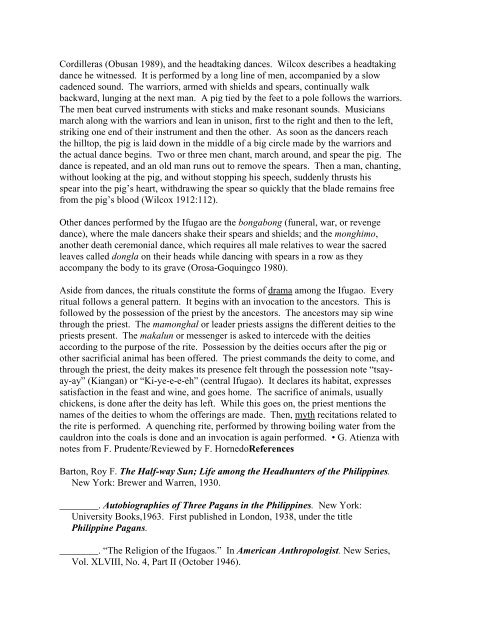“Ifugao” refers to the group of people living in Ifugao province ...
“Ifugao” refers to the group of people living in Ifugao province ...
“Ifugao” refers to the group of people living in Ifugao province ...
You also want an ePaper? Increase the reach of your titles
YUMPU automatically turns print PDFs into web optimized ePapers that Google loves.
Cordilleras (Obusan 1989), and <strong>the</strong> headtak<strong>in</strong>g dances. Wilcox describes a headtak<strong>in</strong>g<br />
dance he witnessed. It is performed by a long l<strong>in</strong>e <strong>of</strong> men, accompanied by a slow<br />
cadenced sound. The warriors, armed with shields and spears, cont<strong>in</strong>ually walk<br />
backward, lung<strong>in</strong>g at <strong>the</strong> next man. A pig tied by <strong>the</strong> feet <strong>to</strong> a pole follows <strong>the</strong> warriors.<br />
The men beat curved <strong>in</strong>struments with sticks and make resonant sounds. Musicians<br />
march along with <strong>the</strong> warriors and lean <strong>in</strong> unison, first <strong>to</strong> <strong>the</strong> right and <strong>the</strong>n <strong>to</strong> <strong>the</strong> left,<br />
strik<strong>in</strong>g one end <strong>of</strong> <strong>the</strong>ir <strong>in</strong>strument and <strong>the</strong>n <strong>the</strong> o<strong>the</strong>r. As soon as <strong>the</strong> dancers reach<br />
<strong>the</strong> hill<strong>to</strong>p, <strong>the</strong> pig is laid down <strong>in</strong> <strong>the</strong> middle <strong>of</strong> a big circle made by <strong>the</strong> warriors and<br />
<strong>the</strong> actual dance beg<strong>in</strong>s. Two or three men chant, march around, and spear <strong>the</strong> pig. The<br />
dance is repeated, and an old man runs out <strong>to</strong> remove <strong>the</strong> spears. Then a man, chant<strong>in</strong>g,<br />
without look<strong>in</strong>g at <strong>the</strong> pig, and without s<strong>to</strong>pp<strong>in</strong>g his speech, suddenly thrusts his<br />
spear <strong>in</strong><strong>to</strong> <strong>the</strong> pig’s heart, withdraw<strong>in</strong>g <strong>the</strong> spear so quickly that <strong>the</strong> blade rema<strong>in</strong>s free<br />
from <strong>the</strong> pig’s blood (Wilcox 1912:112).<br />
O<strong>the</strong>r dances performed by <strong>the</strong> <strong>Ifugao</strong> are <strong>the</strong> bongabong (funeral, war, or revenge<br />
dance), where <strong>the</strong> male dancers shake <strong>the</strong>ir spears and shields; and <strong>the</strong> monghimo,<br />
ano<strong>the</strong>r death ceremonial dance, which requires all male relatives <strong>to</strong> wear <strong>the</strong> sacred<br />
leaves called dongla on <strong>the</strong>ir heads while danc<strong>in</strong>g with spears <strong>in</strong> a row as <strong>the</strong>y<br />
accompany <strong>the</strong> body <strong>to</strong> its grave (Orosa-Goqu<strong>in</strong>gco 1980).<br />
Aside from dances, <strong>the</strong> rituals constitute <strong>the</strong> forms <strong>of</strong> drama among <strong>the</strong> <strong>Ifugao</strong>. Every<br />
ritual follows a general pattern. It beg<strong>in</strong>s with an <strong>in</strong>vocation <strong>to</strong> <strong>the</strong> ances<strong>to</strong>rs. This is<br />
followed by <strong>the</strong> possession <strong>of</strong> <strong>the</strong> priest by <strong>the</strong> ances<strong>to</strong>rs. The ances<strong>to</strong>rs may sip w<strong>in</strong>e<br />
through <strong>the</strong> priest. The mamonghal or leader priests assigns <strong>the</strong> different deities <strong>to</strong> <strong>the</strong><br />
priests present. The makalun or messenger is asked <strong>to</strong> <strong>in</strong>tercede with <strong>the</strong> deities<br />
accord<strong>in</strong>g <strong>to</strong> <strong>the</strong> purpose <strong>of</strong> <strong>the</strong> rite. Possession by <strong>the</strong> deities occurs after <strong>the</strong> pig or<br />
o<strong>the</strong>r sacrificial animal has been <strong>of</strong>fered. The priest commands <strong>the</strong> deity <strong>to</strong> come, and<br />
through <strong>the</strong> priest, <strong>the</strong> deity makes its presence felt through <strong>the</strong> possession note “tsayay-ay”<br />
(Kiangan) or “Ki-ye-e-e-eh” (central <strong>Ifugao</strong>). It declares its habitat, expresses<br />
satisfaction <strong>in</strong> <strong>the</strong> feast and w<strong>in</strong>e, and goes home. The sacrifice <strong>of</strong> animals, usually<br />
chickens, is done after <strong>the</strong> deity has left. While this goes on, <strong>the</strong> priest mentions <strong>the</strong><br />
names <strong>of</strong> <strong>the</strong> deities <strong>to</strong> whom <strong>the</strong> <strong>of</strong>fer<strong>in</strong>gs are made. Then, myth recitations related <strong>to</strong><br />
<strong>the</strong> rite is performed. A quench<strong>in</strong>g rite, performed by throw<strong>in</strong>g boil<strong>in</strong>g water from <strong>the</strong><br />
cauldron <strong>in</strong><strong>to</strong> <strong>the</strong> coals is done and an <strong>in</strong>vocation is aga<strong>in</strong> performed. • G. Atienza with<br />
notes from F. Prudente/Reviewed by F. HornedoReferences<br />
Bar<strong>to</strong>n, Roy F. The Half-way Sun; Life among <strong>the</strong> Headhunters <strong>of</strong> <strong>the</strong> Philipp<strong>in</strong>es.<br />
New York: Brewer and Warren, 1930.<br />
________. Au<strong>to</strong>biographies <strong>of</strong> Three Pagans <strong>in</strong> <strong>the</strong> Philipp<strong>in</strong>es. New York:<br />
University Books,1963. First published <strong>in</strong> London, 1938, under <strong>the</strong> title<br />
Philipp<strong>in</strong>e Pagans.<br />
________. “The Religion <strong>of</strong> <strong>the</strong> <strong>Ifugao</strong>s.” In American Anthropologist. New Series,<br />
Vol. XLVIII, No. 4, Part II (Oc<strong>to</strong>ber 1946).
















